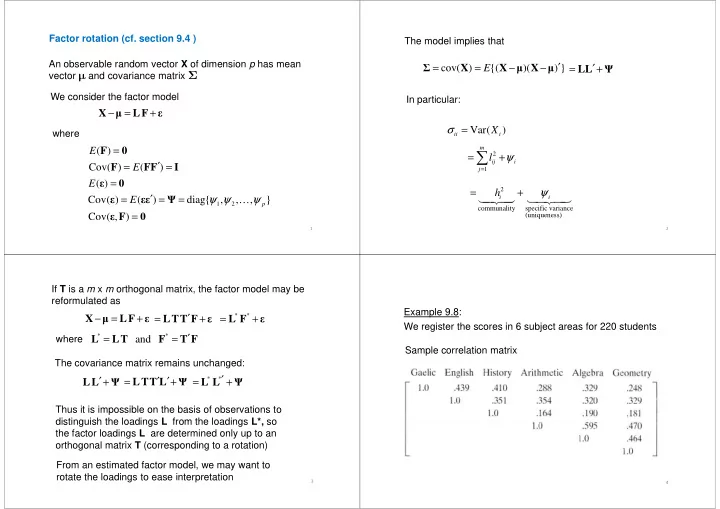

Factor rotation (cf. section 9.4 ) The model implies that An observable random vector X of dimension p has mean ′ = X = X − � X − Σ E � = LL ′ + Ψ cov( ) {( )( ) } vector � and covariance matrix Σ We consider the factor model In particular: X LF − = + � ε σ = σ = X X Var( Var( ) ) where ii i F 0 E = m ( ) ∑ = + ψ l 2 ij i ′ F = FF = I E Cov( ) ( ) j = 1 0 = E ε ( ) = + ψ h 2 ′ = = = ψ ψ ψ E … � � �� i � � � �� i � ε εε Ψ Cov( ) ( ) diag{ , , , } p 1 2 communality specific variance ε F 0 Cov( , ) = (uniqueness) 1 2 If T is a m x m orthogonal matrix, the factor model may be reformulated as Example 9.8: X − = LF + = LTT F ′ + = L F + � ε ε ε * * We register the scores in 6 subject areas for 220 students ′ L = LT F = T F * * where and Sample correlation matrix The covariance matrix remains unchanged: * ′ * ′ ′ ′ ′ ′ LL LL ′+ ′+ = = LTT L LTT L + + = = L L L L + + Ψ Ψ Ψ Ψ * * Ψ Ψ Thus it is impossible on the basis of observations to distinguish the loadings L from the loadings L*, so the factor loadings L are determined only up to an orthogonal matrix T (corresponding to a rotation) From an estimated factor model, we may want to rotate the loadings to ease interpretation 3 4
ˆ ˆ l l ( , ) Plot factor loading pairs ; cf. Fig 9.1 i i Maximum likelihood solution for two factors (R commands 1 2 are given on the course web-page) H Ga Original factors: • First factor: “general intelligence” E • Second factor: “nonmath-math” Ge Rotated factors: Al • First factor: “mathematical ability” Ar • Second factor: “verbal ability” (subjectively rotate -20 degrees) 5 6 The VARIMAX criterion for chooses the rotation matrix T that maximizes Example 9.9: In a consumer preference study a random 2 p p m 1 ∑ ∑ 1 ∑ ɶ ɶ = − V l l *4 *2 sample of customers were asked to rate several attributes of ij ij p p a new product using a 7-point scale = = = j i i 1 1 1 ɶ = l l ˆ h ˆ * * Sample correlation matrix where the are the rotated loadings scaled by / ij ij i the square root of the communalities ɶ ɶ l l h h ˆ ˆ * * After the rotation the are multiplied by to After the rotation the are multiplied by to ij i preserve the original communalities Note that m ∑ variance of squares of (scaled) ∝ V j loadings for th factor j = 1 The criterion aims at “spreading out” the (square of) the loadings on each factor as much as possible 7 8
Principal component solution with two factors and varimax rotated factors (R commands are given on the course web-page) Rotated factors: • First factor: “nutritional” • Second factor: “taste” 9 10 Example 9.10 (and more) We have found a two factor principal component Using the varimax criterion, we obtain the following solution as well as a maximum likelihood solution rotated loadings (R commands are given on the course for the stock-price data (cf. examples 9.4 and 9.5) web-page) Principal components Maximum likelihood F1 F2 F1 F2 morgan morgan 0.763 0.029 0.763 0.029 0.852 0.036 0.852 0.036 citi 0.819 0.232 0.849 0.220 fargo 0.668 0.108 0.812 0.085 0.126 0.912 shell 0.112 0.994 0.078 0.910 exxon 0.109 0.675 The rotated loadings are quite similar The loadings are quite different 11 12
Recommend
More recommend